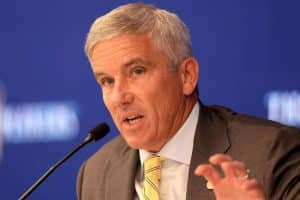The PGA Tour is set to begin testing rangefinders in tournament play in an effort to address the long-standing issue of slow pace. The move comes just after Rory McIlroy captured his first Masters title, completing the career Grand Slam.
McIlroy, 35, pulled off a dramatic win over Justin Rose in a playoff at Augusta National, despite a shaky start that some commentators called “inexcusable.” With the win, he became just the sixth golfer in history to secure all four major titles, joining the ranks of legends like Tiger Woods, who last achieved the feat in 2000.
Commentary around the slow pace of play resurfaced during the tournament, especially from Golf Channel analyst Paul McGinley. He suggested that McIlroy’s early struggles may have been due to his playing partner, Akshay Bhatia, taking too long to hit. “I think he got distracted,” McGinley said. “Bhatia put his second shot in the water and took forever — at least 10 practice swings — before finally playing.”

That kind of delay is exactly what the Tour is hoping to eliminate with the introduction of rangefinders, which will be allowed in select tournaments under a “distance-only” setting. Players will be able to use them during events like the RBC Heritage and Corales Puntacana Championship, and the trial run will wrap up with the Truist Championship and Oneflight Myrtle Beach Classic, according to Golf Digest.
However, there are strict rules. If a player uses features beyond the basic distance mode, they’ll be hit with a two-stroke penalty on the first offense. A second offense? Automatic disqualification.

World No. 1 Scottie Scheffler has already weighed in with a new proposal in light of the controversial policy change.
As for McIlroy, he’s not so sure there’s a simple fix for golf’s slow play problem. When asked before the AT&T Pebble Beach Pro-Am what could help, he admitted he didn’t have a clear answer.
“Courses are getting harder — like at Torrey Pines last week,” he told GOLF.com. “You’ve got fast greens and tough wind. Even on a two-footer, you want to mark it and focus.”

He added that the issue isn’t new: “Slow play has always been around. Even when people really loved golf, it was still slow.”
McIlroy suggested ideas like reducing field sizes or spreading out tee times more, but acknowledged those solutions come with trade-offs. “Smaller fields could help, but that limits playing opportunities and not everyone’s going to like that,” he said. “And in this time of year, tee times are tighter because of daylight, so spacing them out more might not even be an option.”

